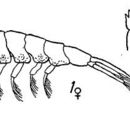Biology
provided by Arctic Ocean Biodiversity 2011
A large, subarctic Atlantic krill, maringally present in the Arctic
- license
- cc-by-nc
- copyright
- Arctic Ocean Diversity
- author
- Alexei Pinchuk
- author
- Russ Hopcroft
Trophic Strategy
provided by Arctic Ocean Biodiversity 2011
Primarily predatory on smaller zooplankton, but can consume algae when abundant; Prey item for fish, squid, decapods, whales, seals, and seabirds
- license
- cc-by-nc
- copyright
- Arctic Ocean Diversity
- author
- Alexei Pinchuk
- author
- Russ Hopcroft
Life Cycle
provided by Arctic Ocean Biodiversity 2011
Females lay several clutches of eggs (brood size 350-550) during spring; Females require repeated mating after each molt to form new egg clutches; Life cycles is typcial: eggs, nauplius, metanauplius, followed by several stages of feeding calytopsis, and furcillia larvae; Juveniles resemble adults, and molt regularly while growing to adulthood over the first year of life; Life expectancy not known, likely 1-2 years
- license
- cc-by-nc
- copyright
- Arctic Ocean Diversity
- author
- Alexei Pinchuk
- author
- Russ Hopcroft
Habitat
provided by Arctic Ocean Biodiversity 2011
Subarctic Atlantic in shelf-break habitats deeper than 200 m, amd some some isolated deep fjords; Transposted into the Chukchi Sea by currents; Undergo diel vertical migrations, spending daytime at 100-400 m (with records to 1500 m), night-time 0-100 m
- license
- cc-by-nc
- copyright
- Arctic Ocean Diversity
- author
- Alexei Pinchuk
- author
- Russ Hopcroft
Comprehensive Description
provided by Arctic Ocean Biodiversity 2011
Transparent, yellowish if rich in lipids, females might develop blue hue when spawning; Eyes round, rostrum absent, photophores red; Small post-ocular spines (one above each eye); Anntennae with backward pointing leaflet, carapace with denticle; Abdominal segments without spines on keel
- license
- cc-by-nc
- copyright
- Arctic Ocean Diversity
- author
- Alexei Pinchuk
- author
- Russ Hopcroft
Distribution
provided by iArczoo
Boreal Atlantic species; can be carried into Arctic waters, but does not reproduce there.
- compiler
- Ershova, Elizaveta
Morphology
provided by iArczoo
The first segment of the stalk of the antennules carries a large lobar process, which nearly reaches the eyes. The carapace is armed with a spine behind each eye; the lateral corners of the carapace are transformed into short sharp points. The endopodite of the uropods is very narrow, almost the same length as the telson. The exopodite is somewhat longer and almost 2 times wider than the endopodite. The lobar processes on the endopodites of the pleopods of males have a characteristic shape (shown on figure).
- compiler
- Ershova, Elizaveta
Size
provided by iArczoo
- compiler
- Ershova, Elizaveta
Northern krill
provided by wikipedia EN
- license
- cc-by-sa-3.0
- copyright
- Wikipedia authors and editors
Northern krill: Brief Summary
provided by wikipedia EN
Northern krill (Meganyctiphanes norvegica) is a species of krill that lives in the North Atlantic Ocean. It is an important component of the zooplankton, providing food for whales, seals, fish and birds. (In the Southern Ocean, Antarctic krill Euphausia superba fills a similar role.) M. norvegica is the only species recognised in the genus Meganyctiphanes, although it has been known by several synonyms:
Euphausia intermedia Euphausia lanei Holt & Tattersall, 1905 Meganyctiphanes calmani Nyctiphanes norvegicus G. O. Sars, 1883 Thysanopoda norvegica
- license
- cc-by-sa-3.0
- copyright
- Wikipedia authors and editors
Distribution
provided by World Register of Marine Species
Arctic to Cape Hatteras
North-West Atlantic Ocean species (NWARMS)
- license
- cc-by-4.0
- copyright
- WoRMS Editorial Board
Habitat
provided by World Register of Marine Species
Floating in open sea, found at depths of 0-500 m .
North-West Atlantic Ocean species (NWARMS)
- license
- cc-by-4.0
- copyright
- WoRMS Editorial Board
distribution
provided by World Register of Marine Species
depth in m: 100-400; horizontal distribution: boreal and arctic Atlantic, Mediterranean
- Kylin, H. (1956). Die Gattungen der Rhodophyceen. C.W.K. Gleerup: Lund, Sweden. xv, 673 pp.
- Mauchline, J. and Fisher, L.R. (1969) The Biology of Euphausiids. Advances in Marine Biology 7: 1-454
- Mauchline J. (1980), The Biololgy of Mysids and Euphausiids. Advances in marine Biology (London), 18, 1-680
- license
- cc-by-4.0
- copyright
- WoRMS Editorial Board

